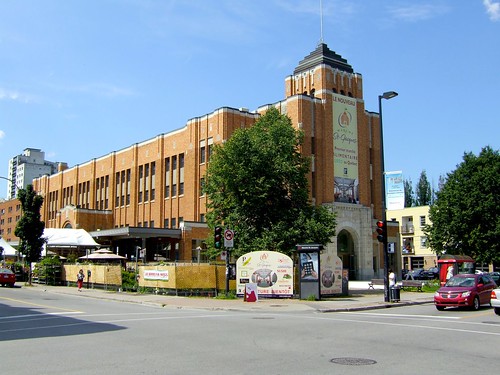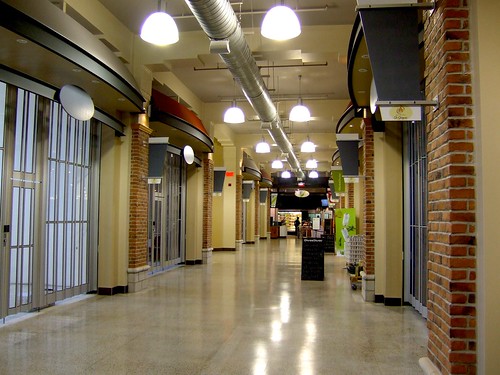Marché Saint-Jacques seen from the corner of Ontario and Amherst.
After years of serving as a city office building, the Marché Saint-Jacques is finally being returned to its original vocation: a public market. Previously owned by the Ville-Marie borough, the market was sold for $2.3 million to private developer Rosdev in 2007 on the condition that it remain a market. This year, after extensive renovations and restoration, new shops are opening up inside the historic market building. There is currently a bakery (Première Moisson), a cheese shop, a greengrocer, a fresh pasta shop, an olive product store, a crêperie, and a coffee and tea shop. Other stores will be opening later this year.
In terms of protecting our city’s heritage buildings, this is good news. The restoration work was well executed and this beautiful Art Deco market will be preserved. Moreover, it will continue to remain accessible to the public, which wouldn’t be the case if it were converted to residential units as has happened to other old public buildings.
Art Deco details on the façade of the market.
But the new market is also a terrible missed opportunity. Public markets can have a great social value. Many low-income neighbourhoods are poorly served by grocery stores, and public markets are a way to provide access to affordable, healthy food. Markets can also provide consumers the opportunity to buy directly from small, local producers, many of whom have to struggle to survive in Quebec’s increasing industrialised and centralised food production and distribution systems.
Unfortunately, the new Marché Saint-Jacques won’t accomplish any of these functions. The new Marché Saint-Jacques isn’t a true public market, but rather a gourmet foods mall. All the shops within it are retailers. Unlike true markets, there are no small producers present. While it might be possible to add additional kiosks outside during the summer, there are currently no plans to do so.
Moreover, few of the neighbourhood’s many low income residents will benefit from the new stores in the market, which sell mainly luxury products. The Centre-Sud has historically been a working class neighbourhood, and to this day 42% of the residents of the Saint-Jacques district are low income. It also has one of the highest concentrations of public housing in the city, after Pointe-Saint-Charles and Sainte-Marie. No fewer than 680 subsidized public housing units can be found within a 250 metre radius of the market, not to mention the fact that les Habitations Jeanne-Mance, one of the largest public housing complexes in Canada, is a only a fifteen minute walk away.
Currently a number of the shops in the market have yet to open.
The way in which the market was redeveloped with thus mainly benefit financially comfortable, relative newcomers to the neighbourhood. It didn’t have to be this way. Economic revitalisation and social inclusion are not a zero sum game. Marché Jean-Talon, for instance, offers something for everybody. Gourmet retailers set up shop next door to discount merchants and local producers selling staple crops at affordable prices.
There are many ways that a social element could have been incorporated into this project, while still making it a revenue generating venture. There is no legitimate reason why the Ville-Marie borough couldn’t have incorporated space for a few local producers, a social enterprise, or a store selling cheap staples, while still leaving space for a few higher-end specialty retailers. Unfortunately, such an option would have meant extra work for the borough and less profits for the private developers. As a result the Ville-Marie borough took the easier route by deciding against these possibilities and simply throwing the entire project to the private sector. What’s worse, in selling the building the borough definitively closed the door to revisiting the market’s set-up.
We are now left with a market which is an improvement over an under-utilised office building, but far less than what it potentially could have been. And it’s one that leaves the neighbourhood’s traditionally working class residents out in the cold instead of building an inclusive community space for all residents.




21 comments
I find it kind of ironic (although ultimately good news) that the city ran the place as an office building but forced the private developer to convert it back to a market.
It seems like the kiosk on the west side of the building (visible in the picture) is selling produce – do you know anythig about that?
I’m so sad about this market supposedly upgrade. there was a nice seasonal market there operated by Claude Plouffe. They had a real variety of produce unlike the outside joke they’ve put up now. I’m also uncomfortable with the renovation job. From Ontario Street -aka the main entrance- you barely see the shops and therefore aren’t encline to go inside. What the neighbourhood really needs is a good butcher, a fish market, maybe a SAQ and a proper seasonal market on the outside.
@Alanah: It isn’t a primary producer, it’s the greengrocer I mentioned. During the warmer months they move part of their operation outside. In general, I find them the most reasonable of the retailers present, and probably the most useful for lower income residents. Still, their prices are pretty much what you’d find in your average IGA or other supermarket.
Je suis vraiment déçu du résultat, si ce que vous dites s’avérait exact. Je croyais que les travaux en cours favoriserais l’implantation d’un marché du type Jean-Talon et/ou Atwater surtout avec le succès que ces derniers semblent connaitre. Dommage encore une fois Montréal mais aussi pour le Centre-sud.
@ Steve: J’ai parlé avec un représentant du promoteur et je peux confirmer que pour l’instant des kiosques de producteurs tel qu’on en retrouve au Marché Jean-Talon ne sont pas prévus. Ce n’est pas quelque chose qui a été écarté a priori, mais il me semble qu’il n’y a pas beaucoup d’intérêt de la part du promoteur.
Moan moan moan. They could have put aside space for a Tibetan women’s knitting collective and there would still be someone Spacing who would find reason to criticize.
It’s still good constructive criticism though. I live in the Centre-Sud, I’m a new owner-resident and although I am not considered lower income, I have no budget to afford these kind of specialty products. I agree, it’s a lost opportunity for lower income but also new young families that are struggling to pay their rent and people buying their first homes. If you add up these different demographics, I wonder if this markets serves even 25% of the neighbourhood. I’ll buy the vegetables though, but that’s about it.
Yes William, real band of radicals around here. Lower food prices.
I agree that it’s not ideal, but sadly, what retailers charge for food, or what tenants a developer attracts, is dependent on the market – and Centre-Sud is increasingly gentrifying.
I see the same pattern in Hochelaga-Maisonneuve at the Marché Maisonneuve – there’s one massive greengrocer, and then a lot of relatively expensive specialty stores. In the hood east of Pie-IX, there’s just a Metro grocery on Morgan and one little alternative (and expensive) food shop on Sainte-Catherine E that sell fresh produce. There’s empty new storefronts at Viau and Ontario — What I wouldn’t give for a little grocery like Tsikinis (on Jarry!) to move in there.
I can only think it’s a matter of economics. Fresh produce has a short shelf life and carrying it is a risk for a retailer; it’s also harder for a smaller retailer to negotiate good prices with suppliers. Cheaper canned / junk food stays on shelves longer – therefore deps thrive where (in theory) local greengrocers used to be.
Back to the immediate subject – the only way for that particular market to support cheaper fresh food would likely have involved government subsidies at the provincial and municipal levels; Who knows? Maybe there’s still room for a food co-op to open in there, all it takes is organizing, cash and political will.
Of course, fresh food is available nearby, just not conveniently or without a car / public transit (i.e. within a 500m radius). Checking good old Google Maps, searching Centre-Sud for ‘epicerie’ pops up a wealth of alternatives – Plenty of smaller greengrocers and a few deps that sell fresh produce, two Metro groceries at different ends of the neighborhood, an IGA at Place Dupuis, two Richelieus, Jovy 2000, etc.
About 24 minutes’ walk west — admittedly not ‘close’ — there’s Segal’s. Sakaris, and 4 Brothers along with smaller stores on St-Laurent, and a quick metro ride north takes you to the panoply of smaller grocery stores along Mount-Royal East.
And if you’re willing to ride a while, the Atwater Market (and its Super C) are on the Green Line, and the J-T market is on the Orange line, both accessible from Berri-UQAM.
I suppose it does come down to economics — grocery stores aren’t obligated to open in poorer neighborhoods. That said, there isn’t the blatant and discriminatory ‘redlining’ that you see in some American cities, where poorer neighborhoods have no fresh food retail at all!
A study was published in 2008, in the Canadian Journal of Public Health, regarding disparities in fresh food availability – Centre-Sud and HoMa look pretty good compared to the West Island, though not as well-served as immediately surrounding neighborhoods. (http://journal.cpha.ca/index.php/cjph/article/view/1582/1772) – PDF download link.
The greengrocer is really the least expensive and the most useful store at the Marché St.Jacques. I ve seen a lot of new products since the store opened. The products, such as legumes (lentilles, rice) dried and in cans or organic products are at this greengrocer less expensive than at Super C!
I think we shouldn’t criticize before the market opens officially (i am not sure if it is the end of october?)
Quand on privatise, la loi de maximisation des profits gouverne le développement. Le nouveau propriétaire a respecté la contrainte de la vocation de marché. Comme seuls des locataires «payants» vendant des produits à forte valeur ajoutée peuvent payer des loyers élevés, il était inévitable que e marché ne serait pas «populaire» au sens d’une contribution à la vie des gens moins fortunés. Il s’intègre par contre totalement dans la gentrification du quartier et la délocalisation des résidants défavorisés vers des quartiers ex-centrés. «Money makes the world a battle field…»
I was wondering when SpacingMontreal would notice that the Marché St-Jacques had essentially been privatized. Some of the interior shops are nice (a good cheese shop in the area is great) but they have basically stripped away the true market. The old summer market had a great selection and great prices for a good mix of local and imported produce, and I visited it several times a week. Since the new setup opened, I have been by barely once a month. I would not be surprised to see the whole market go belly up in a few months, and the city have to retake control again. Specialty shops are fine, but without the basic fruit and vegetable market this surely cannot last…
By the way, many old shoppers of the market walk right by, and go to the Petit Marché St-Jacques, on the other side of de Maisonneuve, where Claude Plouffe has set up shop year round. A lot of the old market’s customers are very loyal and boycott the new place.
The success of markets like Atwater and Jean-Talon demonstrate that it is economically viable to have decent prices on a variety of merchandise in an outdoor market with an indoor portion.
The only think missing from the new Marche St-Jacques is the local farmers outside with decent prices, and perhaps a decent cheese deal (like the 3 for 10$ deals at Atwater).
This would make this market a success.
Specialty shops and a small IGA are not enough to attract loyal customers from any distance, and this market needs to draw from a few km (the village, lower plateau) to work.
Oh, and a decent public space nearby.
I think that Iain hit the proverbial nail on the head: in a market economy, merchants choose what they want to sell (and owners choose their tenants). If it does not work, then they will choose something else. If the government does not feel that it is their role to manage such markets (debatable), then leave it to the people who are assuming the risks to do what they think best.
In Mile End, there is an abundance of fresh produce options. Why? Apparently there is a market for it! And all of the up-scale restaurants which keep opening in the area? Not too many are surviving.
Je suis d’accord que la revitalisation de ce marché soit un rendez-vous manqué mais je crois que c’est la ville qui aurait pu mieux gérer ce dossier. Ceux qui habitent le quartier savent que le marché Plouffe avait un bail qui lui permettait de continuer à tenir son kiosque à l’extérieur mais un conflit avec le promoteur et la ville dont je ne connais pas les détails a fini de l’expulser de cet endroit.
Avant le marché était vivant et populaire et là, ça va devenir comme un mini-Atwater, vivant et … cher! J’habitais rue Walker dans les années 90, avant le boom du canal de Lachine et ce n’était pas les gens de Saint-Henri qui allaient au marché non plus.
Tout ça pour dire que la ville aurait pu essayer faire en sorte que la revitalisation du marché se fasse dans l’esprit populaire du quartier, esprit qui était bel et bien là et que la privatisation a en quelque sorte évacué. Peut-être le nouveau marché va-t-il trouver sa niche, ça devient de plus en plus chic par ici, mais moi, je vais continuer à aller acheter mon pain dans une vraie boulangerie (Ontario/de la Visitation, notamment) et pas dans dans une “expérience de boulangerie”, qui coûte en plus les yeux de la tête.
Bref, je suis content que vous l’ayez souligné!
@patrice. depuis 3 ans, il y a un petit marché public en plein air, au coin Ontario et Iberville (Marché Frontenac), de la mi-juin à la mi-octobre. Il y a aussi un kiosque maraicher aux Habitations Jeanne-Mance, tous les jeudis depuis 2 ans. Il y a d’ailleurs de plus en plus de petits marchés dans différents quartiers montréalais (consulter le site http://www.marches-de-quartiers.ca). Ces marchés sont organisés et tenus par des promoteurs issus et appuyés par la communauté. Ils n’ont pas l’envergure des grands marchés publics et sont principalement des kiosques maraichers. Il y en a d’autres comme le Marché fermier du Plateau et du Mile end, et l’Autre Marché au Technopole Angus.
La Ville s’est délestée de sa fonction de gestion des marchés publics dans les années 90. Les marchés publics comme Jean-Talon et Atwater sont gérés par la Corporation de gestion des marchés publics de Montréal (CGMPM), dont les membres sont les producteurs agricoles et les commerçants. La Ville (via ses arrondissements) est toutefois propriétaire des terrains et des immeubles.Le bâtiment du Marché St-Jacques a été vendu par l’arrondissement Ville-Marie à Rosdev il y a quelques années, ce qui avait fortement déçu la CGMPM.
I’ve walk past and through this “market” a few times. It’s pretty but cold, barely any customers. So the low-income hypothesis is proving to be true.
J’habite à 10 minutes de marche et j’aurais vraiment aimé qu’on implante un marché public et non un “centre d’achats” gourmet, que j’apprécie aussi, mais que malheureusement je ne peux pas me permettre d’y acheter que sporadiquement
Great article, thanks!
Not everyone budgets in the same way. Some people choose to live in more economically viable neighbourhoods so they can afford “luxury” food, some people just would rather spend and spend a lot on food rather than say, going out, cable, or even a car! It’s actually really insulting to keep beating the drum that lower income people must want nothing other than kraft dinner and iceberg lettuce (if they want any produce at all) and that wealthy people all have such fancy varied palates they can’t possible shop at “regular” stores.
Bonjour a tous,
Je suis le propriétaire de la fruiterie du marché st jacques. ainsi de la fromagerie du marché Atwater qui vent les spéciaux 3 fromages pour 10$, je vous promet de faire mon possible d avoir les prix les plus bas et une qualité supérieur de n’importe quel autre fruiterie, en plus cette été je ferais mon possible d’avoir a l’extérieur des excellents produits a des prix compétitif, je suis présent chaque jours au marché et je suis très ouvert a vos suggestion.
Merci
.
Voici bien un des billets qui m’a donné envie de devenir un collaborateur de SpacingMontréal –et vos commentaires à tous rendent humble! À bientôt.